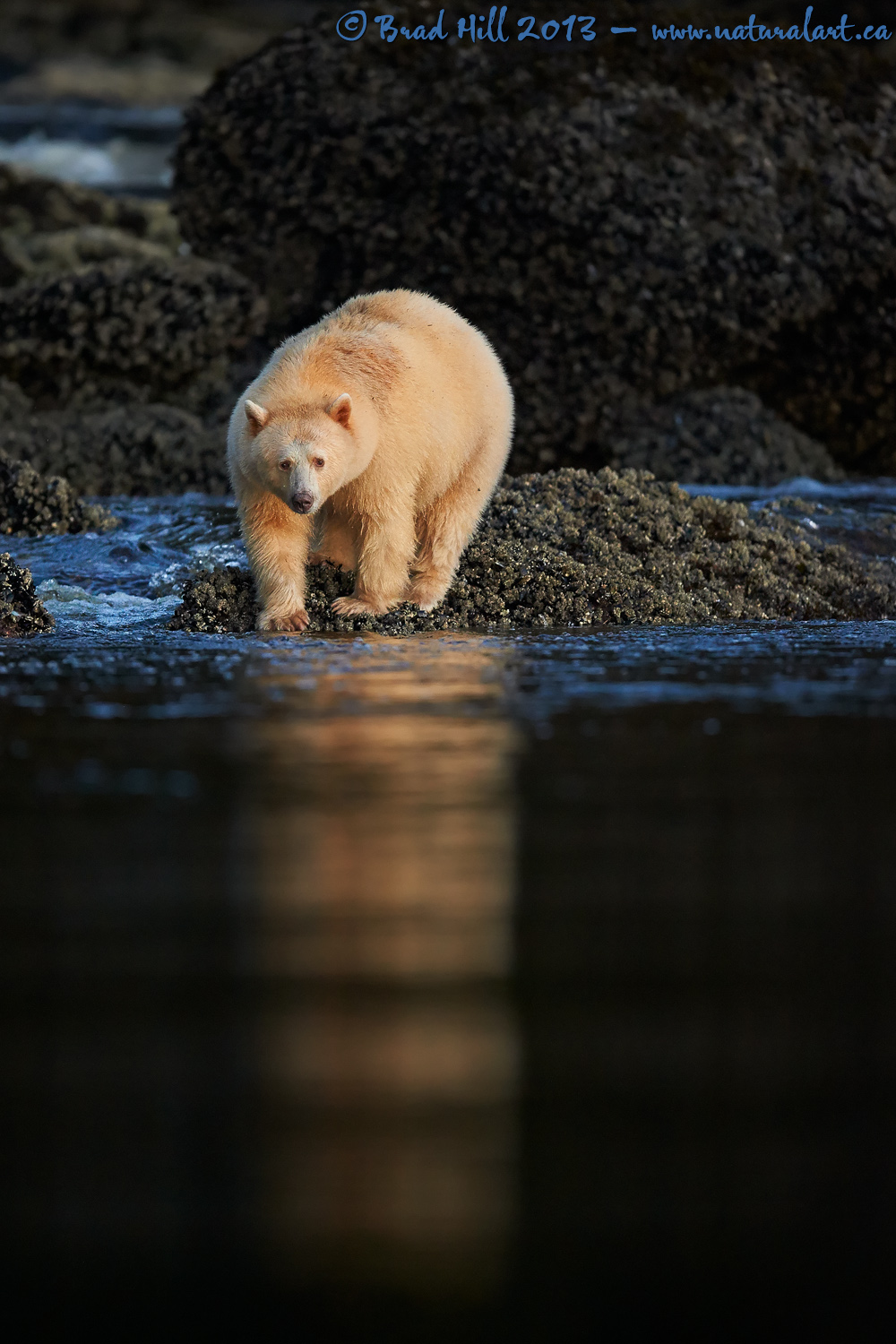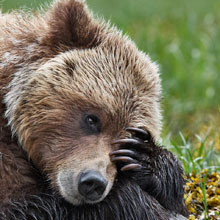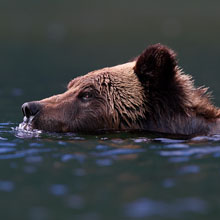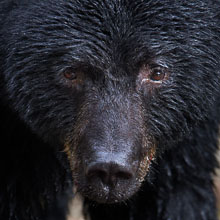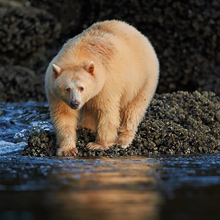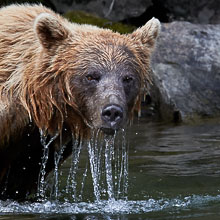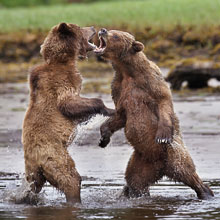Availability: Undetermined - Enquiries?
In the Field
The Spirit of Sunset. Great Bear Rainforest, BC, Canada. October 2, 2013.
It's always a treat to catch a glimpse of the rare "Spirit Bear" that's found within the moody and spectacular Great Bear Rainforest. After all, only about 300 of these rare bears exist in the world. But catching one being kissed by the very last golden rays of sunlight as it poses for you on a remote, barnacle-covered shoreline - well, that's an out-of-this world moment and extreme privilege!
The first of my "Into the Great Bear Rainforest" photo tours in 2013 started off with a big bang. We had spent the bulk of day 1 being entertained by (and photographing) 12-15 Humpback Whales as they went about doing whale things. We were feeling totally satisfied at the end of the day as we headed toward our anchorage for the evening. Then, our eagle-eyed guide spotted this bear on the shoreline WAY off in the distance (thanks again Chris!). The bear was methodically feeding on a mix of salmon and barnacles and seemed content to stay put until we were able to get close to it. For the first 15 minutes or so the bear did interesting things, but was in a tough-to-photograph location (a mix of direct light and harsh shadows and partially obscured by logs). As the light waned we decided to leave the bear alone and move on. As we pulled away in our Zodiac the bear chose to march right out into the open and bid us adieu from the shoreline. And, he gave us this "other-worldly" photo op!
Every photographic situation presents the photographer with a mix of technical and creative challenges to solve. In this situation the bear gave us a beautiful opportunity, but it chose to do so in a way that provided major technical challenges. At the time this image was shot we had almost NO light - it was close to dark. And, the light was directly striking the white bear and little else (so think "extremely high contrast image"). And, we were in a moving Zodiac at the time. And it was a scene requiring a reasonably long telephoto lens, so shutter speed WAS needed.
So...what to do? The first thought is simply to crank up the ISO - right? Well...that was essential (and I cranked it way up to ISO 11,400 for this shot). But, when you crank up the ISO the dynamic range (or light brightness range) that the camera can capture falls - so you lose some of your ability to retain shadow and highlight detail simultaneously. The most critical part of this image is clearly the white bear so the most obvious thing to do in a situation like this (especially at such a high ISO) is to underexpose the image to retain the highlight details. But in doing so you are pretty much guaranteeing that ANY shadow detail will be irretrievably lost (or, if you do "bring it back" during processing it will be a noise-fest). So, I chose to gamble a bit on this shot - rather than underexposing by a stop or more to ensure highlight retention, I underexposed (relative to the matrix-metered exposure "suggestion") by only .33 stops. Why? I really wanted to have at least SOME tonal range in the background of the final image and thought that any apparently blown highlights could be retrieved during processing.
Later that evening - when we were back aboard our floating home for the week - I just had to check the image out to make see if my "gamble" had worked. I was pretty pleased when I opened up the raw file in my preferred raw converter and found that virtually no highlight detail was lost, and that the shadows had blocked up no more than they were when we were viewing the scene! Phew!
ADDITIONAL NOTES:
1. This image - in all resolutions - is protected by copyright. I'm fine with personal uses of them (including use as desktop backgrounds or screensavers on your own computer), but unauthorized commercial use of the image is prohibited by law. Thanks in advance for respecting my copyright!
2. This image was captured during one of my autumn "Into the Great Bear Rainforest" photo tours in 2013. Each year I offer trips into two different parts of the Great Bear Rainforest as well as one to photograph marine mammals and oceanscapes near the northern tip of Vancouver Island. And, in selected years, I also offer photo tours to additional locations to capture other highly sought-after subjects, such as various boreal owl species, fishing grizzlies, and more. Details about these trips can be found on the Photo Tours page of this website.
3. Like all wildlife images on this website, the subject(s) is/are fully wild and completely unconstrained. Besides the potential impact of my/our presence, nothing has been done to intentionally alter or affect the ongoing behavior of the subject and, of course, there has been no use of any form of bait or other form of wildlife attractants (including vocalizations or other sounds).
Behind the Camera
The Spirit of Sunset. Great Bear Rainforest, BC, Canada. October 2, 2013.
Digital Capture; Compressed RAW (NEF) 14-bit format; ISO 11,400.
Nikon D4 paired with Nikkor 400mm f2.8 VR lens. Hand-held from floating Zodiac. VR on and in normal mode.
1/400s @ f3.2; -0.33 stop exposure compensation from matrix-metered exposure setting.
At the Computer
The Spirit of Sunset. Great Bear Rainforest, BC, Canada. October 2, 2013.
RAW Conversion to 16-bit TIFF, including first-pass/capture sharpening using Capture One Pro version 7. Two raw variants (different versions of a single raw capture) differing by a total of 0.67 stops in total exposure.
Further digital corrections on resulting 16-bit TIFF files using Adobe's Photoshop CC and Light Craft's LightZone. Photoshop adjustments included compositing (blrending) of the two exposure variants, minor selective contrast adjustment (via a selective application of a tonal curve adjustment layer), minor selective colour saturation and desaturation, and sharpening for web output. Final tone tweaking performed using tonemapper/re-light tool in LightZone.
Conservation
The Spirit of Sunset. Great Bear Rainforest, BC, Canada. October 2, 2013.
Ten percent of the revenue generated by this image will be donated to Raincoast*.
Species Status in Canada**: Not currently listed as Threatened or Endangered.
The "Spirit" Bear is a rare genetically-based colour variant of the common Black Bear (Ursus americana). It has been estimated that less than 300 Spirit Bears exist today. Because the Black Bear is not considered under threat as a species, the Spirit Bear suffers from having the same conservation designation (it should be acknowledged that in British Columbia - the jurisdiction of greatest Spirit Bear abundance - hunting of these white-coated bears is not permitted). For reasons that are not fully understood, the Spirit Bear occurs with greater frequency in a relatively small geographic area within The Great Bear Rainforest of the central and northern coast of British Columbia. In this area 10 to 30% of the bears possess white coats. Many of the black-coloured Black Bears in this region carry the gene for white coats, so allowing hunting of ANY Black Bears in this region can reduce the frequency of the gene for white coats. Thus, to protect the Spirit Bear, it is necessary to prohibit the hunting of ALL Black Bears in this region. And, very unfortunately, the globally unique ecosystem that contains the Spirit Bear is under development pressure, especially from the forestry industry. If this unique environment is altered, we may lose the wonderful genetic anomaly known as the Spirit Bear forever.
*The Raincoast Conservation Society (and Foundation) is an effective and efficient organization that has been fighting for protection of this unique habitat. If you are looking for a meaningful way to contribute to the conservation of this amazing ecosystem, Raincoast will provide maximal "bang" for your conservation dollars.
**as determined by COSEWIC: The Committee on the Status of Endangered Wildlife in Canada












